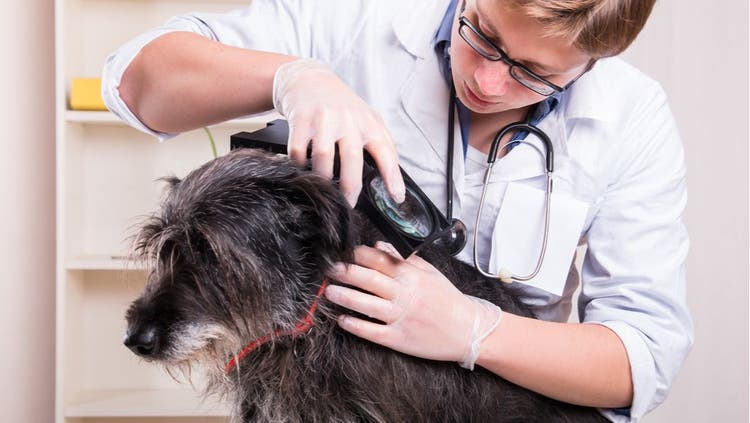
Dealing With Fleas and Ticks in Cats and Dogs
Fleas and ticks can be frustrating to deal with in our household pets. They’re not only irritating, but are also capable of transmitting disease. Dogs and cats can be exposed to fleas in multiple ways, but the most common are:
- Being around other pets that have fleas
- Being in environments that have fleas (fleas can’t live in carpet/furniture), but the eggs can be there and wait for a suitable host to come into contact and then infest them
- Being exposed to farm animals and/or wildlife
Indoor pets are still at risk for flea infestation because they can be exposed to eggs in the environment, since rodents or humans that may have fleas can act as vectors and bring them into the home. Fleas can’t use inanimate objects as hosts but can live in carpet/furniture until they find a suitable host that they can feed on.
The first step in managing flea/tick infestations in dogs and cats is understanding the life cycle of the flea, which can help you get to the bottom of the disease process and stop it.
Flea Life Cycle
Image provided by Centers for Disease Control and Prevention: https://www.cdc.gov/dpdx/fleas/index.html
Knowing the flea’s life cycle helps in treatment, since the focus of treatment should just be focused on adult fleas, but the clearing the environment of eggs. The first step in treatment should always be prevention, which can be accomplished by topical or oral medication provided by your veterinarian on a monthly basis to prevent eggs and infestation. If fleas are noticed and topical/oral medications haven’t been started, that should always be the first step. All pets in the household should be treated along with the affected animal. Remember, not all flea medications can be used interchangeably between dogs and cats. Flea baths and combs can help at the acute stage of infection, but do not stop the cycle from perpetuating.*
The next step is environmental treatment to kill off any eggs present in the home. If the infestation is excessive, consulting a professional exterminator may be necessary. Control the outside environment by minimizing wildlife access and limiting your pet’s access to these areas. Inside the house, throw away any pet beds/blankets that have been exposed. If you’d prefer to save bedding, be sure to wash items at high temperatures and dry. Vacuum regularly, especially in areas where pets reside. Empty the vacuum canisters after finishing and take the trash outside. Foggers can also be used in severe cases, but put pets at risk for exposure. Always contact your chosen pesticide company before proceeding. Also, spot sprays may be useful for furniture or larger objects that can’t be easily be cleaned.
Ticks Life Cycle
The life cycle of the tick is much different from that of the flea. Based on the type of tick, they may have multiple different hosts depending on their age. Yet, similar to fleas, they can transmit diseases to both humans and pets. The life cycle shown below is for the Brown Dog Tick, which is commonly found in southwestern US and Mexico.
Image provided by Centers for Disease Control and Prevention: https://www.cdc.gov/ticks/life\\_cycle\\_and\\_hosts.html
Ticks can exist in an environment and sense hosts based on detecting breathing, body odors, and/or body heat. They are common in long grass and foliage and attach to the host when they pass by inhabited plants. Ticks can not fly or jump to get onto their hosts. Indoor pets are not commonly exposed to ticks unless they are carried into the house by another pet or human.**
If a tick is seen on your pet, use tweezers and remove the tick immediately. You should attempt to remove all of the tick if possible, since the head and mouth may break off during elimination. Do not continue to dig or irritate the skin to remove the remaining parts, since they will ultimately be expelled from the body. You can put a small amount of triple antibiotic ointment over the area as it may become red and irritated. There are specialized tick removal tools that can help in this process of removal, many of which are utilized by hikers and outdoorsman.
Dogs should be on monthly tick preventative, which is usually a topical medication, but may be an oral tablet. Please consult with your veterinarian as to which of these products would be the best fit for your pet. Again, do not assume that dog products are acceptable for treatment of a cat, since they can be toxic to different types of animals. Occasionally even with preventative medication, you may see a live tick on your pet that is not attached this is why you need to check your pet before bringing them indoors, since rogue ticks can also bite you or other indoor pets.
Ticks on rare instances can create an infestation indoors and, in these cases, contacting a professional exterminator is recommended.
For more information about preventative treatments, read our article on The Dos and Don’ts of Flea & Tick Preventatives.
*Anonymous, (2017). Fleas. Centers for Disease Control and Prevention. Retrieved December, 2019
**Anonymous, (2019). How ticks spread disease. Centers for Disease Control and Prevention. Retrieved December, 2019